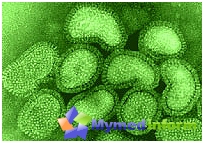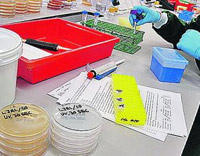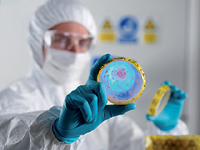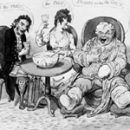Sometimes scientific thought for decades is ahead of its time. Thirty years ago, scientists seem to felt the Achilles of all virus infections - ranging from AIDS and ending with the flu. Then their hopes were not justified, but today we are close to find the universal remedy for the influenza of all types.
Content
An ordinary virus is nothing more than a smart piece of genetic material in a protein shell, which, as a smuggling, is in a cell its genes and uses its molecular mechanism for its own reproduction. But when scientists studied the process of recruiting virus infections, they found a breach in the life cycle of viruses.
When viruses breed, most of them do not care about the accuracy of the genetic code - genome, - and it often lacks a vital part in it «Software code». These defective viruses interfere with the reproduction of their normal fellows and thus have a protective effect. In particular, scientists noted a similar effect when studying viral diseases of plants - feed beans and tours.
The mechanisms of this phenomenon have not yet been studied. According to one of theories, defective viruses simply interfere with the rest to kill their «owner». Biologists also assumed that these viruses play in nature the same role as it was allocated in human society, for example, thieves, fraudsters and deceivers who live through the grave labor of others - only protective viruses live at the expense of other people's proteins.
Whatever it, several decades ago scientists hoped «disperse» This reaction to a unthinkable speed and defeat viral infections. It seemed that this discovery would finally create a cure for a conventional cold, which is caused by numerous viruses falling into the respiratory tract. But when the expected result did not work out, enthusiasm quickly came up. Now this hypothesis is experiencing the second birth.
Animal experiments have shown that with the help of defective viruses, you can provide instantaneous protection against influenza symptoms, slowing the development of infection to such an extent that the body receives time to strengthen immunity against illness.
Injecting the protective virus through the nose will be able to protect against any type of influenza - even Spanish, which in 1918 claimed the lives of 50 million people. According to the main apologist of such studies in the UK, Professor Niphel Dimoc from Warwick University, everything is ready for testing new vaccines on patients.
Dimmok work will create an alternative to traditional vaccination based on stimulating the immune system. When vaccinating, white blood shoulders produce antibodies that are attached to the surface of the virus and begin to kill it. This method has proven itself in the fight against such diseases as an oil, poliomyelitis and cortex, but it is less effective against flu. After all, the genetic code of the influenza virus, recorded in 13.6 thousand nucleotides, is constantly changing, and for the vaccine, these modifications are similar to the moving target for the arrow. Vaccine designed for one type of influenza, for example, H3N2, powerless against the other - let's say, against the virus of bird flu h5n1.
A study published in British Medical Journal showed that there are very little evidence of the effectiveness of seasonal flu vaccines against influenza. And recently a group of scientists from the University of Hong Kong, headed by Professor Yi Guan, reported on the opening of a new deadly strain H5N1. This information strengthened the fear before the appearance of a mutant virus, which will be transmitted to a person and against which existing vaccines will be powerless.
The time of the new form of protection based on the resurrection idea about the defender virus is coming. «As a result of replication errors, all viruses create incomplete versions of their genome. At the same time, these small defective viruses can interfere in the process of replication of RNA of normal viruses. Therefore, we call them RNA interference, or protective», - Explains Professor Dimmok.
A bird flu virus genetic material consists of eight RNA segments. Like normal, «Protective viruses», have only 400 «letters» genetic code, have a protein shell that helps them penetrate into the cells. They affect the same organs as ordinary viruses - light and respiratory system. But they can reproduce only with normal viruses, and since defective RNA is less, it is reproduced faster, and soon protective viruses are greater than normal. «That is why interference RNA can protect us, - explains Professor Dimmok. - But although these properties are easy to see on the example of cell culture, in scientific literature there are very few examples of such therapy».
A big step forward in scientific research was made when scientists understood: although nature creates a variety of types of interference RNA, the best effect is achieved when using the viruses of one type. This can be achieved by laboratory rNA cloning or by choosing a virus that contains one dominant type of interference RNA. «The last way allowed us to get our most active protective virus», - says Professor Dimmok.
In the nature of the protective virus, which intends to use Professor Dimmok, is absent 80% of one of the parts of the genetic code. This specificity makes the virus harmless and does not give it to multiply independently - as an ordinary influenza virus. However, if in a cell where a protective virus got, a different influenza virus is present, it can use its proteins for reproduction, and much faster than their «owner».
Thus, breeding conventional influenza viruses are displaced by a protective virus. This slows down the development of infection, eliminates its symptoms and gives the body time to mobilize the immune system so that it can repulse intervention.
A protective virus as it turns his «full-fledged fellow» in live vaccine. Studies show that it will only act against influenza A, but not against ordinary colds or other respiratory diseases. But it does not need to be adapted to specific strains or mutations of the influenza virus. «Since interference RNA affects the replication process itself, it must be active against any kind of influenza A», - Stresses Professor Dimmok.
This gives a serious advantage at the epidemic, as it is not necessary to spend time to clarify the strain of the virus before deploying a campaign against influenza. Ordinary vaccines are valid only against specific known strains of the virus, and the launch of vaccine production against just appearing subspecies takes not one month.
In addition, the protective virus is a natural by-product of infection - gives constant protection, while the effect of traditional vaccination against influenza may not appear immediately, but for three weeks. Animal tests have shown that the only dose of a protective virus is effective against infection even 6 weeks later. This is its main advantage over antiviral drugs that do not protect and for a day. And although many microbes produce drug resistance, the influenza virus does not become resistant to a protective virus.
«The protective virus works even when the patient receives it within 24 hours after infection», - says Professor Dimmok. He and his colleagues applied for a patent for a protective virus and hoped to conduct clinical trials on patients in the University of Warwick's specially created for this.
Virologist from the London Medical School Queen Mary's School of Medicine, Professor John Oxford says: «This is a discovery at the peak of science, but its development will take a long time. Of course, to have anything that guarantees protection against surprises that the virus presents us is very tempting. I am surprised that none of us did this before, - after all, this discovery lay on our feet».










